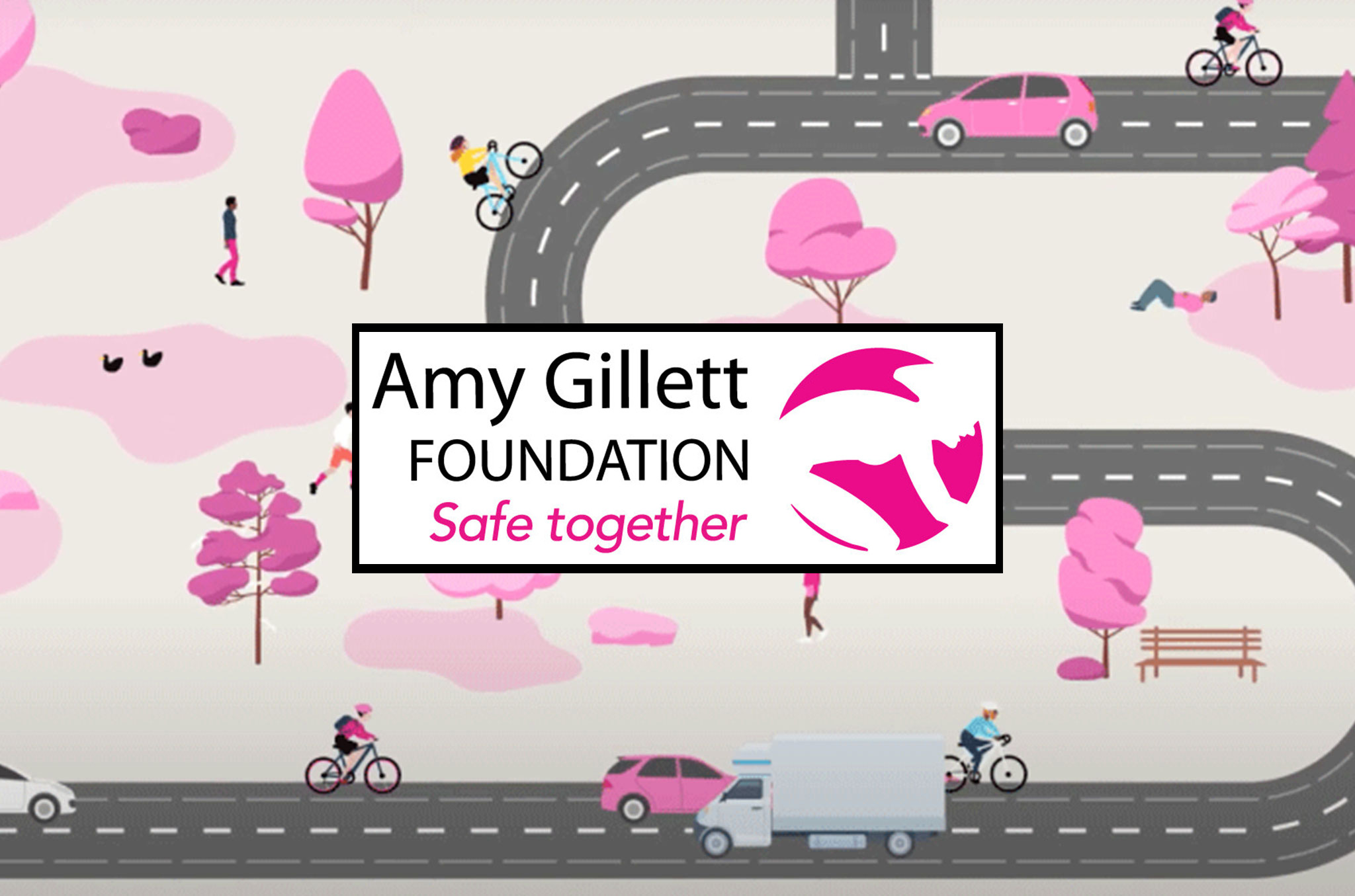Weeks after the Amy Gillett Foundation went into liquidation, a void has been left in the Australian cycling advocacy landscape – and there have been many questions asked about the fate and legacy of one of the nation’s most prominent such bodies. Questions like – how and why did this happen? Questions like – what does this mean for the conditions of bike riders in Australia? But while those questions have been flying around, a group of highly-influential backers have asked another question: how can we resurrect it?
Now, Escape Collective can exclusively report that there is a process in place to bring the AGF back from insolvency. If all the pieces line up, the AGF will be a phoenix from the ashes, picking up more or less where it left off – albeit with a new board and new manager.
Those positioning for this “strategic revival” of the AGF are well-known and respected in Australian cycling. The group behind it includes a proposed board comprising the AGF’s founding Chairman and former Chairman of Cycling Australia and AusCycling, Duncan Murray, Amy’s mother, Mary Safe, influential political strategist Mark Textor (also a former Chairman of the AGF), former WorldTeam title-sponsor Michael Drapac, Australian road cycling legend Phil Anderson, and former World Champion cyclist, media commentator and advocate Kate Bates (a former teammate of Gillett’s, Bates would also serve as General Manager).

There is a delicate path to walk in navigating the liquidation process, returning the organisation to voluntary administration, raising funds to revive it, and appeasing the list of creditors that were left out of pocket by the Foundation’s closure, which includes the Australian Federal Government. But there’s also considerable confidence within the group that the cause can live on. “The AGF and its work is too important to fail – so we’re bringing it back to life," Murray told Escape Collective.
Despite the hurdles ahead, there’s a track record of success in advocacy to draw on, and a sense of unfinished business that set in after the AGF’s closure – from backers of the new venture, to those that weathered the organisation’s closure. One such supporter is Michael Drapac, who has seen both the joy and pain of cycling – after sponsoring teams at both domestic and WorldTour level (including Cannondale-Drapac), Drapac’s own multi-talented son Damion was tragically killed in 2019 after being struck by a driver. “The toll of cyclists’ accidents and deaths are unacceptable and arguably largely avoidable. The AGF’s work is imperative and it will save lives," Drapac said. The backers of the revival include Drapac, Geoff Wilson and John Wylie and a dozen other well-known Australian cycling supporters. Murray said that the full list of backers, as well as the supportive creditors, will be “revealed and thanked in due course”.
With a proposed board of people deeply invested in Australian cycling, drawing across a range of professional and cycling disciplines, the group behind the AGF’s proposed revival feels that it is equipped to bring the organisation back from the brink. If all goes to plan, Murray said, the Foundation can be ready to hit the ground running in around eight weeks, restoring the organisation to its place in the Australian cycling landscape, with a proven team at its helm.
But the resurrection necessarily sits in a broader context: were it not for the insolvency, the noble effort to revive it would not be necessary. So how did we get here, and what comes next? In this Escape Collective exclusive, after numerous interviews with those at the Foundation in its last days and those hoping to bring it back, we can reveal the plan for the future, the legacy of the past, and the context of the closure.
A bit of back story
The Amy Gillett Foundation was born out of tragedy – the death of the talented young Australian cyclist, Amy Gillett, who was crashed into by an inexperienced driver while training with the national team in Germany. Gillett had a vibrant life ahead and an accomplished one behind: a PhD student at the University of SA, she had also represented Australia as a rower at the Atlanta Olympics, was a national champion on the track in the individual pursuit, and medalled in the individual time trial national championship in 2005, the year of her untimely death.
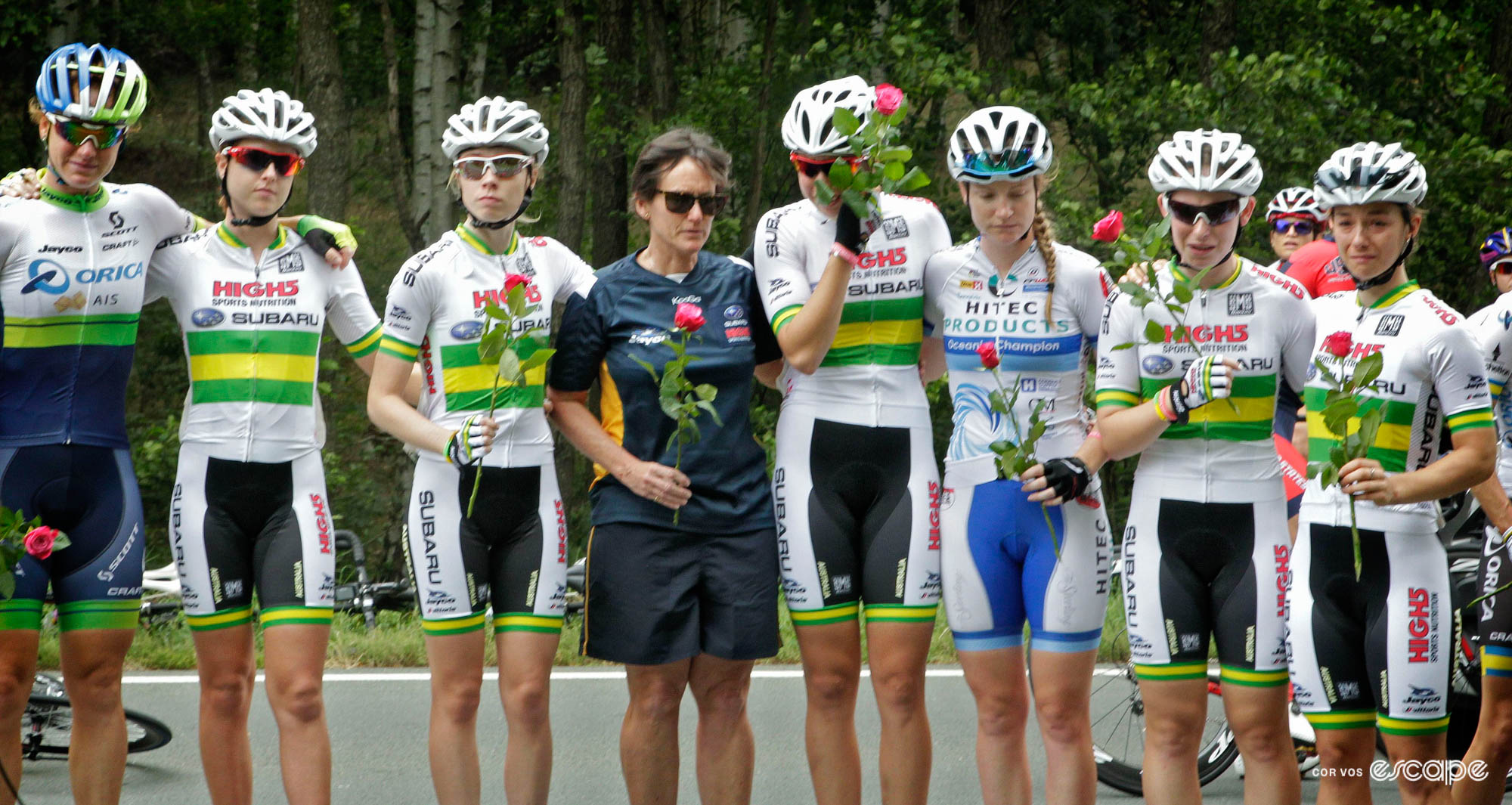
Rather than letting her death be a tragic full-stop on her life, those close to her resolved to let her legacy live on. By 2006, a foundation in her name had been established to advocate for safer riding conditions with the support of her parents and her husband, Simon Gillett. Separately to its advocacy work, the AGF also oversaw a scholarship program for female cyclists (past recipients included Grace Brown and Sarah Gigante) and was the fundraising partner of the popular Amy’s Gran Fondo event on the Great Ocean Road. [Event organisers O2 Events told Escape Collective that "event stakeholders provide permits to O2 Events to host the year-on-year event, so there will be an event in 2024 – still to be determined is if the Amy Gillett Foundation are involved."]

From 2009, the AGF’s major campaign was the push for the ‘A Metre Matters’ safe-passing measure which was eventually adopted nation-wide in 2021, when Victoria became the last state to adopt the legislation. With the adoption of safe-passing legislation nationally, the AGF repositioned as a more general advocacy body, partnering with Australia’s peak cycling sports body AusCycling on a number of programs, and in 2023 secured a major grant from the Federal Government to conduct the ‘Safe Roads for Safe Cycling’ program. This $6m grant was a profound outlier in the cycling advocacy space; the Federal Government rarely funds cycling initiatives as they are typically administered and enacted at the council or state level. It was an innovative multidisciplinary program which combined crowdsourced mapping, trained hundreds of engineers to produce favourable cycling outcomes, and had the potential to significantly improve conditions for those accessing the dataset – from councils to bicycle user groups to state and federal governments.
But despite this endorsement of the foundation’s nous in the space, it would also prove to be a point of contention as the organisation entered its final days.
The beginning of the end (for now)
There was little indication that anything was wrong until the email landed on the last day of February, late in the afternoon. In a letter to stakeholders, written by Lisa Jacobs – the AGF chair – came the news that the foundation was being wound up. Concrete details were scarce as the liquidation proceedings began – the organisation’s social media profiles were dormant, its website left without updates, its phone ringing without answer (it is now disconnected). The closure sent shockwaves through the world of Australian cycling, and brought an organisation with a strong legacy to an undignified end – until, that is, the new plan for its revival.
Speaking to Escape Collective two months after the AGF’s closure, the emotion is still raw for Jacobs. “The day when we had to appoint the liquidator – it was a really confronting day for everyone. It's not something that I ever want to go through again… it's a whole group of people who devote their lives to this – no one's in it to get rich, everyone's in it because they believe in cycling safety,” she said.
Like many not-for-profit organisations, the Amy Gillett Foundation was staffed by people passionate about the cause, none of them taking home lavish pay-packets, and with a volunteer board.
But while not-for-profits by definition don’t need to take in any more money than they are investing in their own operations, they still need money coming in to keep the lights on, and the organisation’s funding streams came from government grants – like that for Safe Roads for Safe Cycling – as well as philanthropy and income from events like Amy’s Gran Fondo.
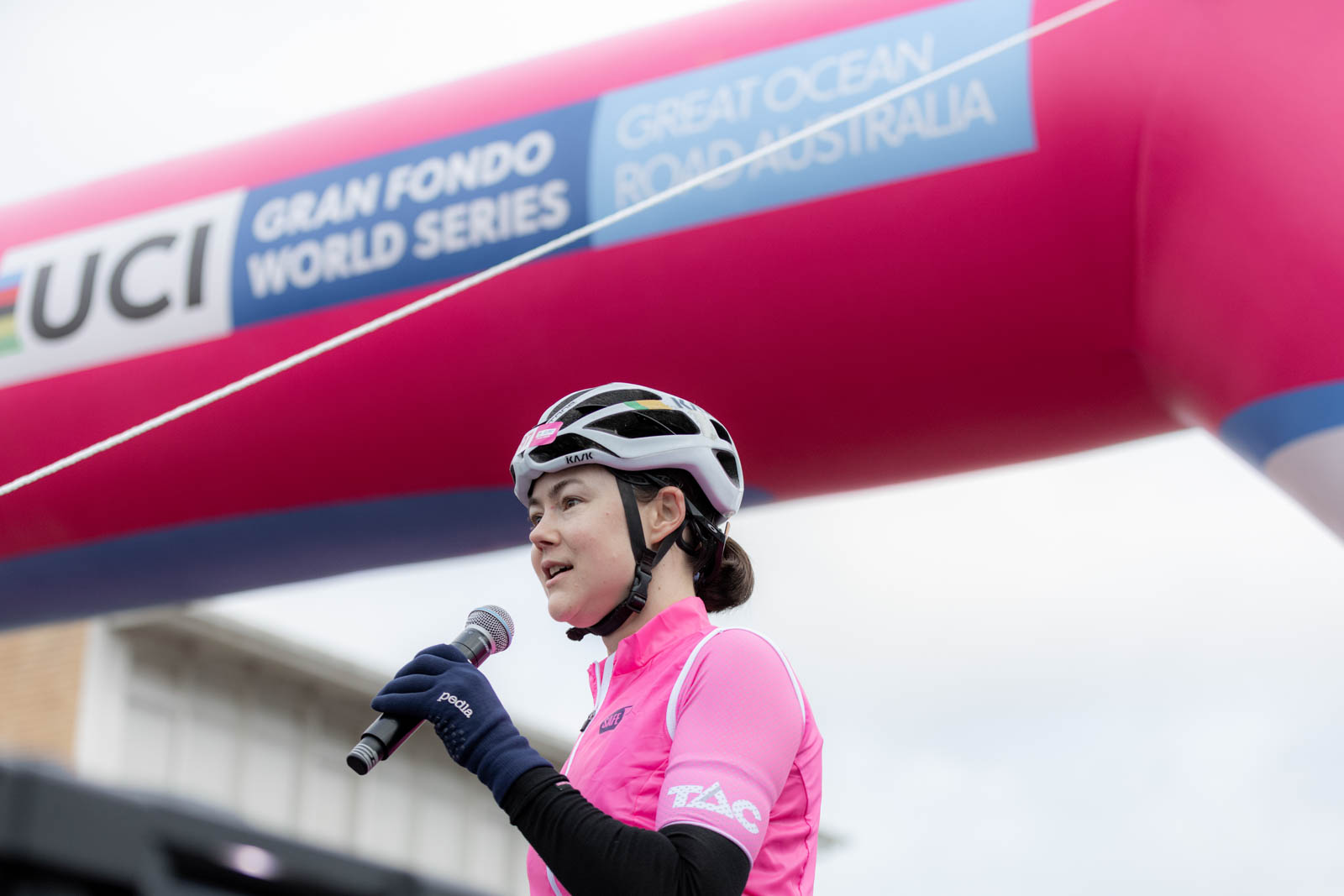
Despite the organisation’s relatively lean operation, there remains little clarity on how financially stable it was. Annual reports have not consistently been made public through the Australian Charities and Not-For-Profit Commission, and the last financial report made publicly available appears to have been for the financial year ending in June 2019, showing a loss of over $180,000 on top of a $346,000 loss the year earlier, with revenues down 15%. [Speaking to Escape Collective, the AGF’s chair Lisa Jacobs said that there was "no obligation" for the organisation to make public its financial position, but that it was audited each year and acted with integrity.] Sources within the organisation, speaking on the condition of anonymity, suggested that while there was an awareness that money was tight, the organisation’s closure had come as a surprise. The rest of Australian cycling found out about the AGF’s closure mere hours after its own employees, who had gone to work that morning thinking it was an ordinary Thursday, and been pulled into an all-hands meeting that afternoon. Immediately afterward, the company was in the hands of its liquidators, Cor Cordis.
In documents lodged to the Australian Securities and Investments Commission (ASIC) in mid-March by the AGF’s liquidator, the foundation’s financial position was laid out in black and white. Assets: $196,429. Amount owed to employees (including superannuation): $140,000. Amount owed to unsecured creditors: $446,757. An estimated deficiency, once the dust had settled, of $1,087,909. (The liquidation process is still ongoing, so these figures are subject to change; Cor Cordis provided a statement to Escape Collective that “a detailed report outlining our findings will be provided to creditors and stakeholders within three months of the appointment”; ie late May).
The list of creditors – 26 in total – ranges in the amounts owed from large to small. At one end of the spectrum, almost $95,000 in unpaid rent at the co-working space the Foundation used on Queen Street, Melbourne; on the other, a $524.60 tab at the café downstairs.
One separately-listed contingent creditor, however, is prominent both in its heft as an entity and the amount claimed: the Office of Road Safety, a body under the Federal Government’s Department of Infrastructure, Transport, Regional Development, Communications and the Arts, which had awarded the $6m Safe Roads for Safe Cycling grant (Escape Collective understands that the AGF was expected to contribute an additional $1.2m in value, either in-kind or directly). The government’s claim on that grant? More than $850,000.

That sat in apparent conflict with comments by AGF chair Lisa Jacobs (also a three-time national CX champion), who in the letter to stakeholders upon the foundation’s closure – to this day the organisation’s sole communication on the matter – wrote that “the board has concluded that ongoing operation of the foundation is no longer sustainable in the absence of new federal government funding”. In comments to the Guardian in the days following, the assistant minister for infrastructure and transport, Senator Carol Brown, said that of the $6 million that had been allocated for the Safe Roads for Safe Cycling program, $4.5 million had been paid out. However, there seemed to be a swipe at the AGF beyond withholding the remaining tranche of funding: “Grants need to be spent in accordance with conditions agreed as part of the funding process,” Brown said. “The Department has been in discussions with the foundation since before December over the provision of necessary information as part of the conditions of the grant. Those discussions have been ongoing.” [Speaking to Escape Collective, Jacobs said that the “government asked us questions, we answered them. They asked us more questions; we answered them. We had no outstanding questions in relation to how the funds are being discharged.”]
It’s difficult to reconcile the fact that the AGF’s sole statement about its closure appeared to point the finger at the Federal Government, while the Federal Government’s response is that the funding may not have been spent in accordance with the terms by which it had been allocated, hence the withholding of the final tranche. Two months after the fact, Jacobs is keen to put to bed any uncertainty about this: “If it wasn't for the department, we wouldn't have been able to do this really valuable work,” she told Escape Collective. “My complete focus is on making sure the foundation's integrity is maintained, and that if there is any opportunity for it to continue that we give it the best possible chance. The foundation has always been a friend to everyone – that's been a source of our success, that we don't take sides. We're here to help all cyclists.”
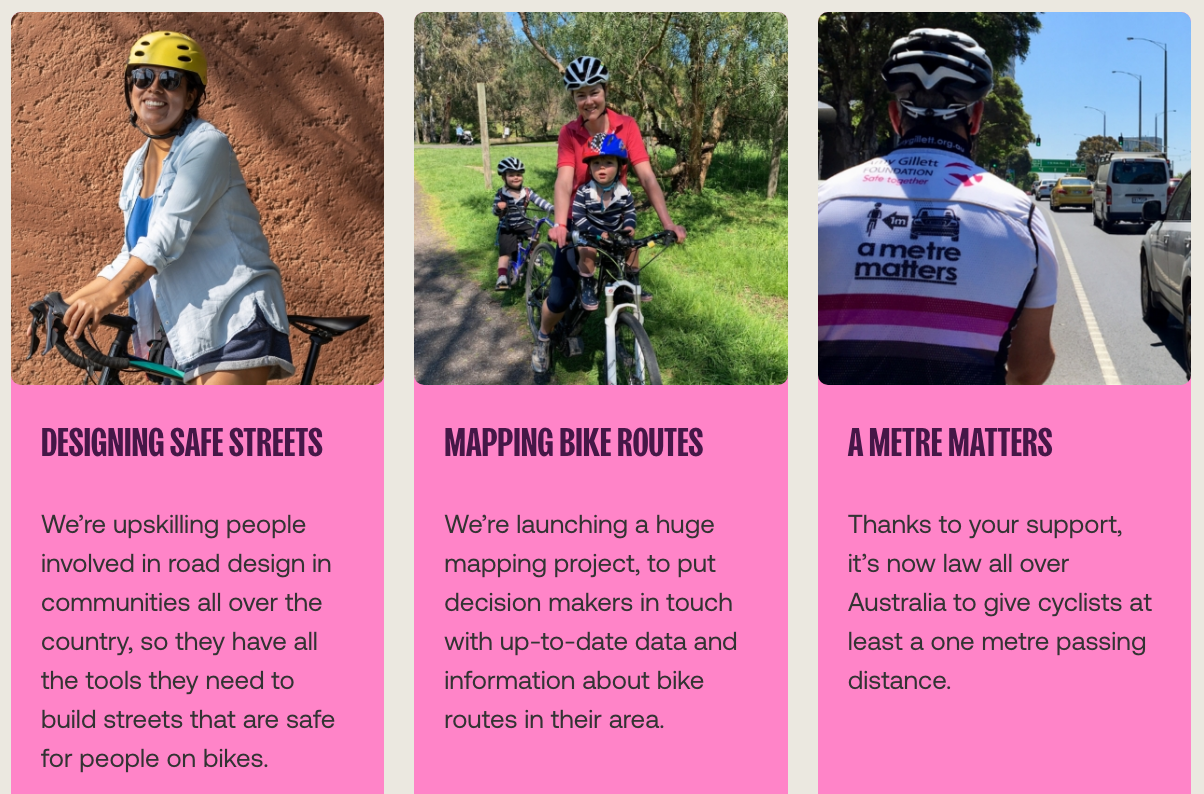
As Jacobs describes it, the Foundation’s closure was a “perfect storm”, particularly in relation to the philanthropic streams funding the AGF. Despite the appointment in 2020 of a CEO who was considered an expert in the fundraising space (Dan Kneipp) and the later enlistment of philanthropy strategists DGB Global (themselves AGF creditors to the tune of $22,000), enough money was not coming in, either for operational expenses or to fund its share of the Safe Roads for Safe Cycling program. “In the last couple of years we saw cost of living pressures increase, and I think probably donor fatigue as well …. The private donations that we’d gotten in the past were getting harder and harder to get. Any foundation is expensive to run – and you know, we don’t sell merchandise or have revenue sources other than donations and grants,” she explained. Former employees speaking to Escape Collective on the condition of anonymity felt that the Foundation’s “over-reliance” on philanthropic streams was key to its downfall, and that some of the targets were “never going to happen” – and all this was against the backdrop of ongoing discussions with the Federal Government for the committed funds.
That’s the nitty-gritty of how the AGF got to this point, but in a way, how it happened is secondary to the outcome, which resulted in the closure of a leading organisation in its space and the loss of more than a dozen jobs.
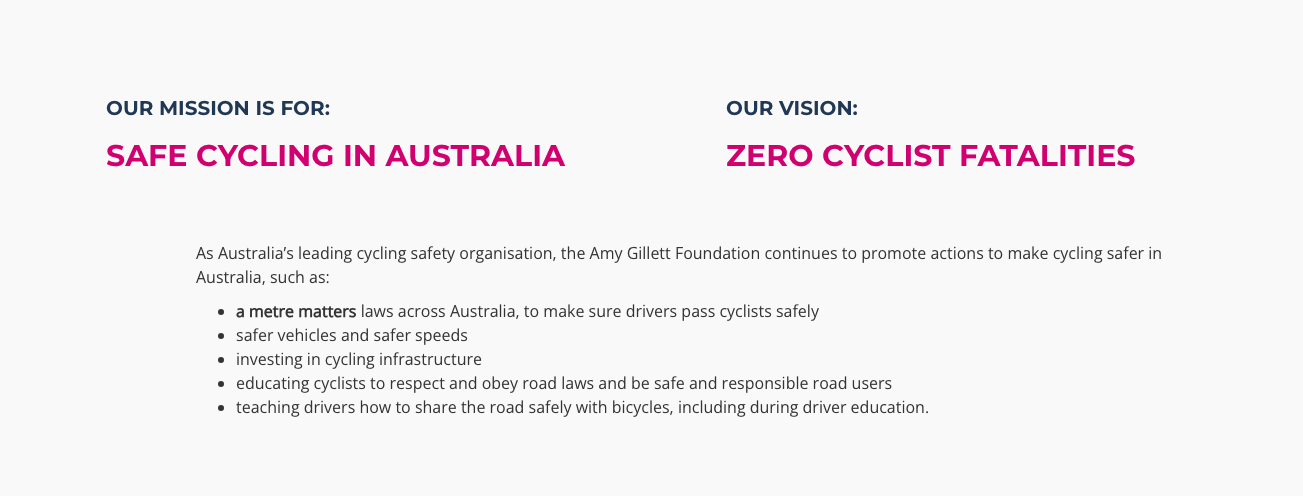
That’s a point that is, repeatedly, returned to by the multiple sources who spoke to Escape Collective for this story. “These are people involved in the Foundation – real people who put their heart and souls into trying to improve cycling safety … integrity is so core to everything that we have done,” an emotional Jacobs told Escape Collective. “We just hope that it will continue.”
More bluntly, Andy Sheats – the AGF’s final acting CEO, for the final month or two up to the end – said that “the [board] and the AGF staff have worked with integrity to achieve the good things we have accomplished —including the 'metre matters' legislation across Australia. That said, we could not secure the financial support necessary to keep the foundation alive, and it simply ran out of cash. Not much more to it than that.”
What next?
So where does the Amy Gillett Foundation go from here?
There’s work to be done, but work is already well-advanced on the reboot; Escape Collective understands that a majority of creditors are supportive of the new venture. If the proposal to step the AGF back from a liquidation process and then through a voluntary administration process occurs, it is also likely to result in better outcomes for both former employees and creditors. The final obstacle is whether the Federal Government stands in the way of the resurrection by seeking remuneration for their claim on the grant. That would be an unpopular decision, and in the scope of a national budget measured in billions would amount to squabbling over cents – as Adam Lana, former AGF head of marketing put it, “you don’t even get a roundabout for $6 million … but the Safe Roads for Safe Cycling program has trained hundreds of engineers, and there were a lot of positive outcomes already from the program”.
Perhaps another major hope from the program is that all that good work will be revived. For BikeSpot, which was deeply involved in the Safe Roads for Safe Cycling program (and through its parent entity CrowdSpot is currently a creditor to the tune of more than $67,000) there’s optimism that it won’t all have been for nothing. “The beautiful thing is that BikeSpot has been successful, with over 70,000 submissions,” Anthony Aisenberg, Director of CrowdSpot and founder of BikeSpot, mapping partner of the ‘Safe Roads for Safe Cycling’ program told Escape Collective. “There's a lot of people that see value in the data – bike organisations to Local and State Governments. That's a really strong foundation to build upon and I want to make sure that is doesn't go to waste - that it is utilised to inform future improvements for safe cycling infrastructure.”
The AGF’s absence has also reinforced to other bodies in the space that perhaps there’s strength in numbers, too. “Everyone with a stake in road safety recognizes the huge effort the AGF made to push bike rider welfare higher up the national agenda and get it the political attention it deserved,” Bicycle Network CEO Alison McCormack told Escape Collective. “With the support of our members, other aligned organisations and key road safety and enforcement agencies, we will keep the pressure up for the changes needed to ensure the rights of riders are fully recognised every time they head out.”
Adam Lana, who’s spent a lot of time thinking about how to improve conditions for cyclists in Australia – both while working for the AGF and in the time after that – is optimistic for the future of cycling advocacy, especially if the Federal Government gets on board again as they did with Safe Roads for Safe Cycling. “There’s an opportunity for some really serious leadership in the space,” Lana said. “I think the opportunity lies with the federal government for behaviour change and campaigns on a national scale, to help address the issues that cyclists face.” (In the 2024 budget, $100 m has been allocated to “a new national Active Transport Fund that will upgrade and deliver new bicycle and walking paths” – a good start, but there’s still a gap in the behaviour change space that advocacy groups including, hopefully, the new Amy Gillett Foundation can fill).
But perhaps the most poignant expression of hope in the revival of the Amy Gillett Foundation – if and when it gets through the process – is from Amy’s parents, who suffered unimaginable loss but have seen her name live on. “Our daughter’s legacy is a testament to the change that passionate advocacy and community support can bring,” Mary and Denis Safe said in a joint statement. “We’re dedicated to seeing this foundation not just continue, but thrive, as a beacon of safety and awareness for all Australian cyclists. Its revival would give us such joy.”
Did we do a good job with this story?

